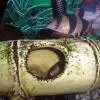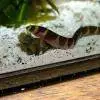Burmese loach - Botia histrionica
Scientific name: Botia histrionica
Common name: Burmese loach
Family: Cobitidae
Usual size in fish tanks: 9 - 11 cm (3.54 - 4.33 inch)
014
Recommended pH range: 6.5 - 7.5
Recommended water hardness: 6 - 10°N (107.14 - 178.57ppm)
0°C 32°F30°C 86°F
Recommended temperature range: 25 - 29 °C (77 - 84.2°F)
The way how these fish reproduce: Spawning
Where the species comes from: South Asia
Temperament to its own species: peaceful
Temperament toward other fish species: peaceful
Usual place in the tank: Bottom levels
Origin of the Fish
The Burmese Loach (Botia histrionica) originates from the freshwater rivers of Myanmar (Burma), particularly found in the Ataran River basin. In the wild, they inhabit fast-flowing rivers and streams with sandy or rocky substrates. The water in these natural habitats is typically well-oxygenated, slightly acidic to neutral, and densely vegetated. Mimicking these conditions in the aquarium is key to their health and well-being.
Lifespan
The expected lifespan of a Burmese Loach in captivity is around 6 years, although they can live longer with optimal care. Maintaining stable water parameters, a clean tank environment, and providing a varied diet contribute significantly to their longevity.
Short Description
Burmese Loaches are small, curious, and peaceful bottom-dwellers, growing to an average size of 9-11 cm (3.54-4.33 inches) in captivity. They are known for their active and inquisitive nature, often seen investigating their surroundings and burrowing in the substrate. Their striking yellow and black striped pattern makes them a beautiful addition to community aquariums. Due to their social nature, they thrive best when kept in groups of at least 5 or more. These loaches prefer a strong water flow and high oxygen levels in the tank, requiring a well-maintained filtration system.
General Care
Burmese Loaches are generally hardy and peaceful, making them a good choice for both intermediate and experienced aquarists. A tank size of at least 90 cm (36 inches) in length and a volume of 100 liters (26 gallons) is recommended to accommodate a small group of loaches. These fish prefer the bottom levels of the tank, so providing plenty of hiding spots, such as caves, driftwood, and plants, is essential to make them feel secure.
A sandy substrate is ideal for Burmese Loaches, as they enjoy burrowing and foraging for food. They require a strong water flow and high oxygen levels, so using a quality filtration system is crucial. A sponge filter is a great addition to a filter that provides a strong flow of water, as it helps maintain water quality while offering gentle filtration. A canister filter with an adjustable flow rate is also ideal. Regular water changes (20-30% weekly) are necessary to maintain water quality. Ensure the water temperature is kept between 25-29°C (77-84.2°F) with a pH range of 6.5-7.5. The water hardness should be between 6-10°N (107.14-178.57 ppm).
Compatible Tankmates
Burmese Loaches are peaceful toward both their own species and other fish, making them suitable for community tanks. Ideal tankmates include other peaceful bottom dwellers and mid-level swimmers, such as:
- Zebra Loach (Botia striata)
- Clown Loach (Chromobotia macracanthus)
- Pearl Gourami (Trichopodus leerii)
- Neon Tetra (Paracheirodon innesi)
- Corydoras Catfish
Keep them in groups of at least 5 to encourage natural behaviors and reduce stress. Avoid keeping them with overly aggressive or much larger species that could intimidate or harm them.
Food and Feeding
Burmese Loaches are omnivores with a hearty appetite. They will readily accept a wide variety of foods, including quality flakes, pellets, bloodworms, brine shrimp, and daphnia. To mimic their natural diet, include vegetable matter such as cucumber, zucchini, and blanched peas. Feeding them twice a day in small portions helps prevent overfeeding and maintains water quality. Providing a varied diet not only keeps them healthy but also enhances their vibrant coloration.
Sexing
Sexing Burmese Loaches can be challenging, as there are minimal visible differences between males and females. However, mature females tend to have slightly larger and rounder bellies compared to males, particularly when they are carrying eggs.
Breeding
Currently, there are no confirmed reports of successful breeding of Burmese Loaches (Botia histrionica) in home aquariums. In the wild, they are known to be seasonal spawners, laying eggs during the rainy season in fast-flowing streams. To encourage potential breeding, replicate these conditions in the aquarium with a strong current and optimal water parameters. However, successful breeding in captivity may require specialized techniques that have yet to be fully understood.
Pictures
Bought by aqua-fish.net from jjphoto.dk.







 Horseface
Horseface  Horseface
Horseface  YoYo
YoYo  Bengal
Bengal  Myanmar
Myanmar  Blue
Blue  Zebra
Zebra  Clown
Clown  Dojo
Dojo  Kuhli
Kuhli  Loach
Loach  Tiger
Tiger  Tailspot
Tailspot